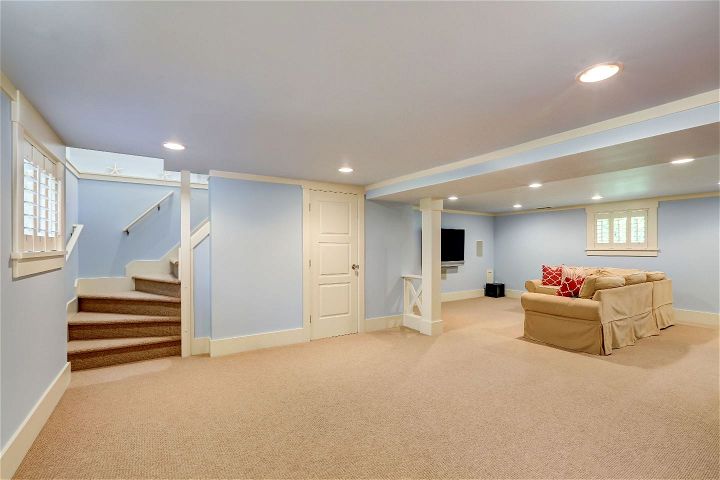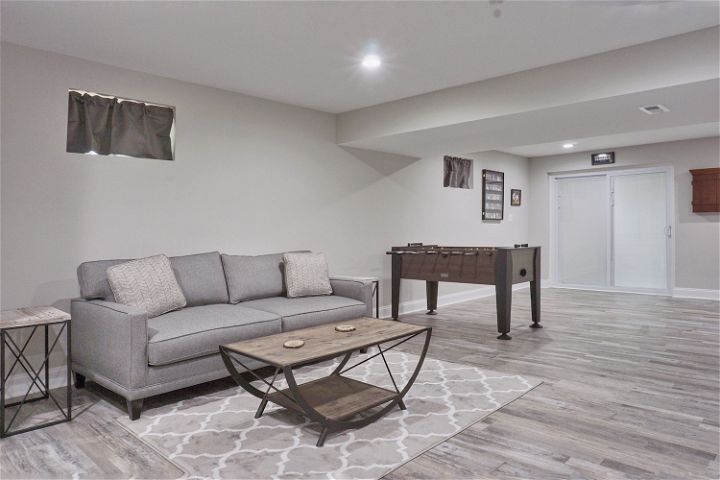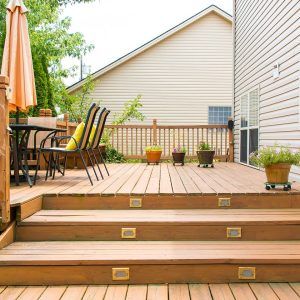You put an outstanding amount of time and effort into finishing your basement, transforming it into livable rooms for your family. However, now that it’s done, you can’t help but notice how low the ceilings are in your brand-new space. Obviously, you can’t raise the rest of your home to increase the ceiling height, and digging your basement deeper is fraught with extreme challenges and expenses, as well. So, what are you to do?
While there might not be any way to make your basement ceilings any taller, you can improve the look and feeling of the space with a few simple and affordable design changes. Here are the hacks you need to finish your basement and fall in love with the space — despite the low ceilings.

Use Flush-mount Lighting and Fixtures
You want to adorn your ceiling with attractive light fixtures, but you don’t want to take up even more headspace and effectively lower your ceilings even farther. That means that you will need to select flush-mount options for your basement spaces. Unlike other styles, flush-mount fixtures have no space between the ceiling and fixture, which means they only take up a few inches of headspace.
If you think that all flush-mounts look like the dreaded, builder-grade boob light of the 1990s, you should think again. Lighting designers have released an almost infinite array of flush-mount light fixtures in different sizes and styles to suit every interior aesthetic. You might even consider installing a flush-mount ceiling fan, which in addition to illuminating your basement will also improve air circulation, making the space feel more comfortable year-round.
Carefully Consider Your Paint Colors
Conventional wisdom suggests that lighter paint colors, like whites and light grays, make a room feel more spacious. This is why ceilings have been painted white for much of living memory; the bright color tends to amplify illumination and create the illusion that walls are taller than they actually are. You might opt to paint your basement walls and ceiling in lighter tones to capitalize on this well-known and highly regarded trick.
Then again, darker and moodier interior colors are remarkably trendy right now, and many home decorators believe fervently that when walls and ceiling are painted in darker tones, they make a space feel larger, like a dark and mysterious cavern. This could work especially well in basement rooms, which are likely already suffering from a limited amount of natural light. Especially if you tend to be more daring in your home design, you might choose to cover your basement walls and ceiling in dark hues.

Opt for Shorter Furniture
Often, the basement is the room that collects the old and unwanted furniture from the rest of the house, which means it is likely to house an ugly, overstuffed sectional, a blocky farmhouse-style table and other enormous pieces that make the space feel especially crowded. If you want your basement to feel spacious and luxurious, you will need to invest in pieces chosen with the room’s dimensions in mind.
To be specific, you should look for seating that tends to be shorter and closer to the ground. You may be able to remove tall legs on some sofas and chairs and replace them with shorter feet, which is easier when you purchase from big-box furniture stores like IKEA. You can also cut down taller furniture that you already own to suit the lower profile of the furniture you buy to fill your space.
Keep Storage Solutions Hidden
While it might not seem like the cabinets that are lining your basement walls are impacting the feeling of your ceiling’s height, the fact is that every square foot in your basement matters when you are trying to create the illusion of spaciousness. Even small amounts of clutter on your end tables can make your basemen feel claustrophobic to some guests, so you need to be careful about cleaning up and keeping your storage solutions out of sight. You might try to optimize your under-staircase storage and build closets into the walls of your basement, so you don’t need to waste floor space on cabinets or shelving.
Your basement’s low ceiling shouldn’t be its defining feature. You can work with a low ceiling to create a fantastic and functional space — as long as you make some of the superior design choices listed above.




